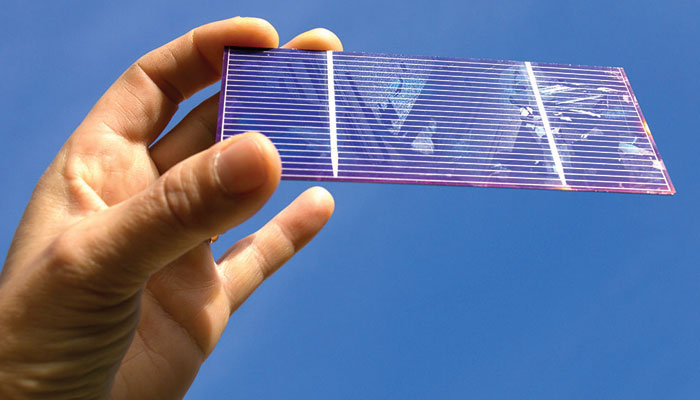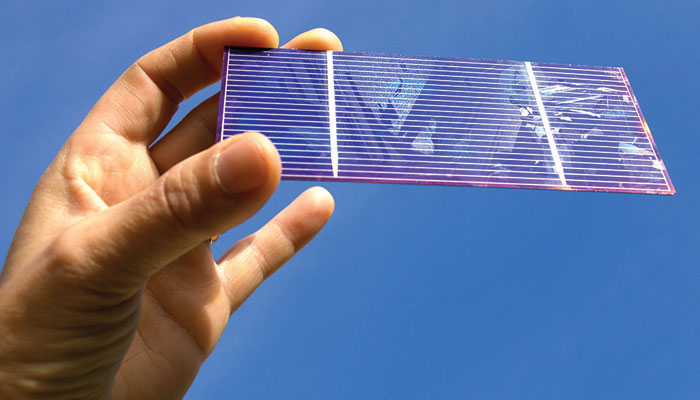
Solar energy is considered to be the cheapest source of renewable energy and this source of energy is of utmost importance to tackle the climate crisis. Due to the power crisis, many people are facing problems. To solve this problem, scientists are creating new things. Last year, researchers in a laboratory in England lit a solar-powered lamp with a tiny solar cell just one centimeter square. The device consisted of cells that were stacked on top of each other.
The bottom is made of a type of silicon used in a typical solar panel, but the top is made of perovskite, a crystal structure that specifically converts electricity into light. . The solar cell, meanwhile, converted 28 percent of the light into electricity. This was a record for a perovskite silicon device to work when the tiny golden cells were placed in a small plane at the National Renewable Energy Laboratory (NREL) in Leer-du. A silicon solar panel has an efficiency of 23 percent, compared to a theoretical silicon efficiency of about 92 percent.
Silicon mainly uses the red and infrared of solar energy. Perovskites, on the other hand, can make more use of the light that reaches them and work in different parts of the spectrum. According to experts, two materials can be combined in a cell as a pair to convert more photons into electrons. Their special feature is that they can convert even less electrons alone. In 2016, the German factory Bosch Solar (bosh solar) used it and by the end of 2017, it will supply the perovskite and silicon-based solar cells to the market. had started
The scientists designed the two materials so that they look like other conventional solar panels, are sealed the same way, and are installed the same way. According to Joey Berry, head of the perovskite research program at the National Renewable Laboratory, there is a whole set of things that would make it a viable technology. But the list of technologies trying to compete with silicon is long.
In the 2000s, efforts were made to introduce more flexible solar energy materials, including thin-film technologies such as cadmium toluride and prandium-calcium silicate. This includes organic solar cells. Given this, experts speculated that such materials would be relatively cheap to produce and could be produced in a variety of sizes. But silicon solar panels were a fast-moving target. 2000 By the middle of 2000, the modular cell of the country and its share in the global market had started.
Commercial silicon panel prices halved from 2010 to 2013 and no equivalent was developed, but the theoretical efficiency of a single layer of perovskite solar panels can reach 33 percent when tandem. The efficiency of a perovskite silicon device can be as high as 43 percent. The advantage of higher efficiency is that you can generate more power or generate more energy with less cost from a smaller footprint.
Silicone panels, on the other hand, have several stages in their production process, in which the silicon is subjected to an intense heat treatment process. Perovskite, on the other hand, can be produced at low temperatures and in liquid form using materials such as plastics. The company’s chief technical officer, Thomas Toombs, says that silicon requires expensive and precise plants and machines because perovskite can be flexible, semi-transparent and lightweight. Can go where heavy, rigid solar panels don’t work.
In addition, according to Ujol Jain, CEO of NREL-affiliated startup SoftSolar, the company is trying to make perovskite tandem solar cells. They are used in two layers and each of them It is used in different parts of the spectrum. It is also used in drones and electric vehicles to increase their range. This type of cell works very well with a silicone layer and is more flexible and lightweight.
New solar technologies like perovskite can essentially help eliminate the need for natural fuels, says Veerun Sivaram, chief technology officer at ReNew Power. But a question arises, why do we need silicon to compete with coal plants if we have cheap solar power plants? This is because the problem with solar power plants is that if they are generating enough electricity into the grid, the capacity of subsequent plants to generate additional electricity is reduced. This is because solar farms do not generate electricity at night.
On the other hand, the system can generate much more electricity in summer. This is already happening in cities with better solar energy production. Like Germany, China and California. According to the NRL report, the cheapest commercial system has a total cost of 1.06 per watt. It costs more due to expensive hardware installation and wiring. Sivaram says that perovskite is the best material for solar energy. Cheap solar energy can also reduce the cost of other things, such as seawater treatment, artificial plants that can remove carbon dioxide from the atmosphere. or electrolysis plants that can convert excess energy into hydrogen fuel. According to studies so far, perovskites quickly degrade when exposed to ultraviolet light and moisture.
In this regard, researchers have set a new record for solar cell efficiency last year. Solar cell efficiency is the amount of energy that a solar cell makes using sunlight. According to experts, technological innovations in the past decade have dramatically increased the capacity of solar cells. But now this achievement is being hailed as a big step towards clean energy. Researchers at the Helmholtz Zentrum Berlin (HZB) used a unique cell technology and produced electricity using 32.5 percent of solar radiation. This is a major breakthrough, says Professor Steve Ulbrecht. Couldn’t see it before.
The perovskite/silicon tandem technology is very effective for sustainable energy supply. Each solar cell only creates a potential of half a volt, but by connecting many solar cells in an L array, we can increase this voltage. Twelve solar cells together make a module that is enough to charge a cell phone.
Many such modules are installed together to meet the energy needs of a home. The only thing moving in a solar cell is the electrons, which after doing their work return to the same cell from where they were emitted. There is nothing that wears out or corrodes over time, so solar cells can last for many years.
setTimeout(function(){
!function(f,b,e,v,n,t,s)
{if(f.fbq)return;n=f.fbq=function(){n.callMethod?
n.callMethod.apply(n,arguments):n.queue.push(arguments)};
if(!f._fbq)f._fbq=n;n.push=n;n.loaded=!0;n.version=’2.0′;
n.queue=[];t=b.createElement(e);t.async=!0;
t.src=v;s=b.getElementsByTagName(e)[0];
s.parentNode.insertBefore(t,s)}(window,document,’script’,
‘https://connect.facebook.net/en_US/fbevents.js’);
fbq(‘init’, ‘836181349842357’);
fbq(‘track’, ‘PageView’);
}, 6000);
/*setTimeout(function(){
(function (d, s, id) {
var js, fjs = d.getElementsByTagName(s)[0];
if (d.getElementById(id)) return;
js = d.createElement(s);
js.id = id;
js.src = “//connect.facebook.net/en_US/sdk.js#xfbml=1&version=v2.11&appId=580305968816694”;
fjs.parentNode.insertBefore(js, fjs);
}(document, ‘script’, ‘facebook-jssdk’));
}, 4000);*/



